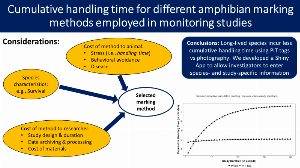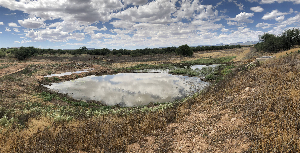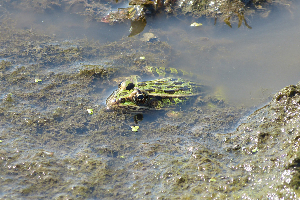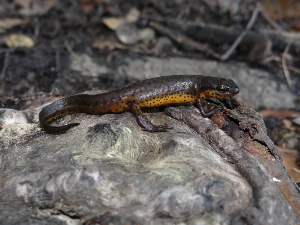Search ARMI Database
Search term(s)
Contribution Number
Search Results
180 record(s) found.
Papers & Reports Trade-offs in initial and long-term handling efficiency of PIT-tag and photographic identification methods
Papers & Reports Amphibian population responses to mitigation: relative importance of wetland age and design
Papers & Reports Resilience of native amphibian communities following catastrophic drought: evidence from a decade of regional-scale monitoring
2. We synthesized a decade (2009 – 2019) of amphibian survey data from multiple monitoring programs across the California Bay Area and used occupancy modeling to estimate the influence of drought, invasive species, and land use on species’ persistence and colonization probabilities. The geographic and temporal scale of our dataset, consisting of 2574 surveys of seven species in 473 ponds, allowed us to quantify regional trends for an entire community of pond-breeding amphibians.
3. An extreme drought from 2012 – 2015 resulted in losses of breeding sites, with 51% of ponds drying in 2014 compared to <10% in non-drought years. Pond drying reduced persistence rates, and nearly every species exhibited reduced occupancy during the drought, with some species (American bullfrogs and California newts) declining by > 25%. Drought reduced occupancy via additional mechanisms beyond habitat loss; for example, lower spring precipitation (an important cue for breeding) was associated with reduced colonization.
4. During drought, native species’ persistence was higher in permanent relative to temporary ponds, even though these sites were also more likely to contain invasive fish and bullfrogs, which generally reduced native amphibian occupancy. Many of these permanent ponds dried during the worst year of drought, leading to extirpations of invasive species that appeared long-lasting. In contrast, native species rebounded quickly with returning rains and showed evidence of full recovery.
5. Synthesis and applications: Despite experiencing one of most severe droughts in a millennium, native species displayed high resilience. Due to longer recovery times by non-native relative to native species, drought presents a valuable management opportunity to remove invaders from key refugia, and we highlight the value of maintaining hydroperiod diversity to promote the persistence of multiple species.
Papers & Reports Staggered-entry analysis of breeding and occupancy dynamics of Arizona Toads from historically occupied habitats of New Mexico, USA
Papers & Reports Thermal conditions predict intraspecific variation in senescence rate in frogs and toads
Papers & Reports Sex-related differences in aging rate are associated with sex chromosome system in amphibians
Papers & Reports Why disease ecology needs life-history theory: a host perspective
information on the nature of the host-parasite interaction to inform management decisions.
However, it is becoming increasingly clear that the life-history strategies of host species
can be predictive of individual- and population-level responses to infectious disease, even
without detailed knowledge on the specifics of the host-parasite interaction. Here, we argue
that a deeper integration of life-history theory into disease ecology is timely and necessary
to improve our capacity to understand, predict, and mitigate the impact of endemic and
emerging infectious diseases in wild populations. Using wild vertebrates as an example, we
show that host life-history characteristics influence host responses to parasitism at different
levels of organization, from individuals to communities. We also highlight knowledge gaps
and future directions for the study of life-history and host responses to parasitism. We
conclude by illustrating how this theoretical insight can inform the monitoring and control
of infectious diseases in wildlife.
Papers & Reports Density dependence and adult survival drive dynamics in two high elevation amphibian populations
Papers & Reports Accommodating the role of site memory in dynamic species distribution models using detection/non-detection data
Data Release Data realease for manuscript: A statistical forecasting approach to metapopulation viability analysis
News & Stories Information from ARMI surveys guides management action in the Desert Southwest
The Buenos Aires National Wildlife Refuge (BANWR) has developed a new pond designed to replicate ciénega conditions that will provide habitat for the federally threatened Chiricahua leopard frog. Reintroduced to the Refuge after extirpation in the early 2000s, the Chiricahua leopard frog has colonized areas beyond the initial reintroduction sites, now inhabiting several human-made stock tanks on the Refuge. The species’ persistence on the Refuge depends on the ongoing eradication of invasive bullfrogs and the availability of water. In desert habitats such as BANWR, the ciénega (a Spanish word for wetland) is a marsh-like habitat that is critical for numerous desert-dwelling creatures. Ciénegas on BANWR are characterized by a spring or seep that saturates the soil and allows water to pool in small areas (Hendrickson and Minckley, 1985). Ciénega vegetation includes rushes, watercress, and smartweed; they are often bordered by cottonwood and willow trees which the Refuge will plant at the new ciénega once the water has settled into the excavated depression. The new ciénega on BANWR is plumbed, meaning that water levels can be modified and maintained in response to environmental conditions that range from multi-year droughts to heavy monsoon conditions (Bezy et. al. 2007).
ARMI has collected data at BANWR since 2000, gathering information about native species (e.g., Chandler et al. 2015, Jarchow et al. 2016, , Howell et al. 2018, 2020a), invasive species such as American bullfrogs and sunfish (Suhr 2010, Howell et al. 2020b), and disease (Sigafus et al. 2014). Models assessing occupancy and movement of the Chiricahua leopard frog indicate that water availability and permanency are critical components to the its persistence at BANWR. The Refuge has used this information to make decisions about management actions such as building plumbed ponds — a non-trivial action in terms of cost and logistics. The new ciénega will not only support the Chiricahua leopard frog but will provide water for many other species that call BANWR home including the federally endangered masked bobwhite quail, great blue herons, yellow-billed cuckoos, and pronghorn.
Bezy, J., C. F. Hutchinson, and C. J. Bahre. 2007. Buenos Aires National Wildlife Refuge, 373 Arizona. Desert Plants 23:3–44.
Chandler, R., E. Muths, B. H. Sigafus, C.R. Schwalbe, C. Jarchow, and B.R. Hossack. 2015. Realizing the potential of spatially explicit metapopulation theory for predicting extinction risk. Journal of Applied Ecology. DOI: 10.1111/1365-2664.12481.
Howell, P., E. Muths, B.R. Hossack, B.H. Sigafus, and R.B. Chandler. 2018. Increasing connectivity between metapopulation ecology and landscape ecology. Ecology 99: 1119-1128.
Howell, P.E., B.R. Hossack, E. Muths, B. Sigafus, A. Chenevert- Steffler, and R. Chandler. 2020a. A statistical forecasting approach to metapopulation viability analysis. Ecological Applications 30(2), e02038
Howell, P.E. E. Muths, B.H. Sigafus, and B.R. Hossack. 2020b. Survival estimates for the invasive American bullfrog. Amphibia-Reptilia.
Hendrickson, D. A. and W. L. Minckley. 1985. Ciénegas vanishing climax communities of the American southwest. Desert Plants 6 (3): 131-175.
Sigafus, B. H., C.R. Schwalbe, B.R. Hossack, and E. Muths. 2014. Prevalence of the amphibian chytrid fungus at Buenos Aires National Wildlife Refuge, Arizona. Herpetological Review 45: 41-42.
Suhre, D. O. 2010. Dispersal and demography of the American Bullfrog (Rana catesbeiana) in a 455 semi-arid grassland. M.S. Thesis, University of Arizona, USA.




